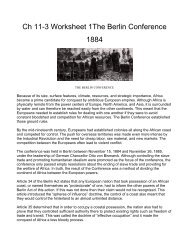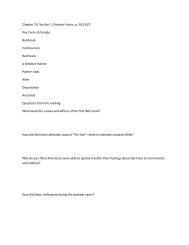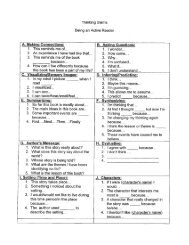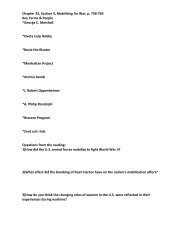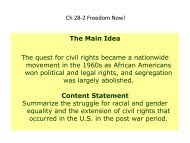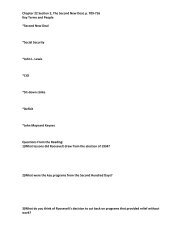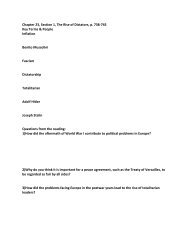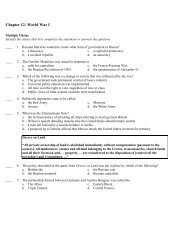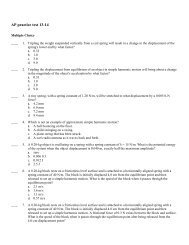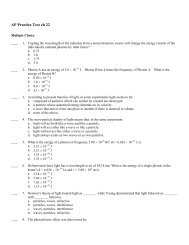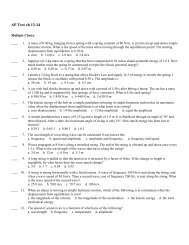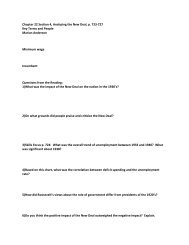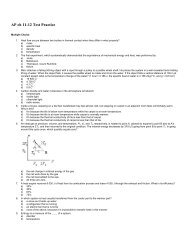ch 19-20 practice - Geneva Area City Schools
ch 19-20 practice - Geneva Area City Schools
ch 19-20 practice - Geneva Area City Schools
You also want an ePaper? Increase the reach of your titles
YUMPU automatically turns print PDFs into web optimized ePapers that Google loves.
AP Test <strong>ch</strong> <strong>19</strong>-<strong>20</strong><br />
Multiple Choice<br />
____<br />
1. An electron moves through a region of crossed electric and magnetic fields. The electric field E = 2 000 V/m<br />
and is directed straight down. The magnetic field B = 0.80 T and is directed to the left. For what velocity v of<br />
the electron into the paper will the electric force exactly cancel the magnetic force?<br />
a. 2 500 m/s<br />
b. 4 000 m/s<br />
c. 5 000 m/s<br />
d. 8 000 m/s<br />
____<br />
2. A wire is lying horizontally in the north-south direction and the horizontal magnetic field is toward the east.<br />
Some positive <strong>ch</strong>arges in the wire move north and an equal number of negative <strong>ch</strong>arges move south. The<br />
direction of the force on the wire will be:<br />
a. east.<br />
b. down, into the page.<br />
c. up, out of the page.<br />
d. There is no magnetic force.<br />
____<br />
3. A circular loop carrying a current of 1.0 A is oriented in a magnetic field of 0.35 T. The loop has an area of<br />
0.24 m 2 and is mounted on an axis, perpendicular to the magnetic field, whi<strong>ch</strong> allows the loop to rotate. If the<br />
plane of the loop is oriented parallel to the field, what torque is created by the interaction of the loop current<br />
and the field?<br />
a. 5.8 N m<br />
b. 0.68 N m<br />
c. 0.084 N m<br />
d. 0.017 N m<br />
____ 4. A proton moving with a speed of 3.0 10 5 m/s perpendicular to a uniform magnetic field of 0.<strong>20</strong> T will<br />
follow whi<strong>ch</strong> of the paths described below? (q p = 1.6 10 <strong>19</strong> C and m p = 1.67 10 27 kg)<br />
a. a straight line path<br />
b. a circular path of 1.6 cm radius<br />
c. a circular path of 3.1 cm radius<br />
d. a circular path of 0.78 cm radius<br />
____<br />
5. A proton, whi<strong>ch</strong> moves perpendicular to a magnetic field of 1.2 T in a circular path of radius 0.080 m, has<br />
what speed? (q p = 1.6 10 <strong>19</strong> C and m p = 1.67 10 27 kg)
a. 3.4 10 6 m/s<br />
b. 4.6 10 6 m/s<br />
c. 9.6 10 6 m/s<br />
d. 9.2 10 6 m/s<br />
____<br />
____<br />
____<br />
____<br />
6. A proton with initial kinetic energy E is moving in circular motion in a uniform magnetic field. When it has<br />
completed one eighth of a revolution, what is its kinetic energy?<br />
a. 1.4 E<br />
b. 0.71 E<br />
c. E<br />
d. The value is not given.<br />
7. A 100-m-long wire carrying a current of 4.0 A will be accompanied by a magnetic field of what strength at a<br />
distance of 0.050 m from the wire? (magnetic permeability in empty space µ 0 = 4 10 7 T m/A)<br />
a. 4.0 10 5 T<br />
b. 2.0 10 5 T<br />
c. 1.6 10 5 T<br />
d. zero<br />
8. A current in a long, straight wire produces a magnetic field. The magnetic field lines:<br />
a. go out from the wire to infinity.<br />
b. come in from infinity to the wire.<br />
c. form circles that pass through the wire.<br />
d. form circles that go around the wire.<br />
9. Two long parallel wires 40 cm apart are carrying currents of 10 A and <strong>20</strong> A in the opposite direction. What is<br />
the magnitude of the magnetic field halfway between the wires?<br />
a. 1.0 10 -5 T<br />
b. 2.0 10 -5 T<br />
c. 3.0 10 -5 T<br />
d. 4.0 10 -5 T<br />
____ 10. Two parallel conductors are carrying currents in the same direction. The currents are non-zero and not<br />
necessarily equal. The magnitude of the magnetic field midway between them is 40 T. If one of the currents<br />
then has its direction reversed, what is the resulting magnitude of the magnetic field midway between them?<br />
a. a value greater than 40 T<br />
b. 40 T<br />
c. a value less than 40 T<br />
d. It could be any value.<br />
____ 11. Two parallel wires are separated by 0.25 m. Wire A carries 5.0 A and Wire B carries 10 A, both currents in<br />
the same direction. The force on 0.80 m of Wire A is:<br />
a. 3.2 10 -5 N.<br />
b. 2.6 10 -5 N.<br />
c. 1.6 10 -5 N.<br />
d. less than 1.0 10 -5 N.<br />
____ 12. Solenoid #1 has a length L, cross-sectional area A, and N turns. Solenoid #2 has a length 2L, cross-sectional<br />
area 2A, and 2N turns. Whi<strong>ch</strong> solenoid has the greater magnetic field at its center when equal currents are<br />
going through them?<br />
a. #1
. #2<br />
c. Both have the same magnetic field.<br />
d. Since it depends on the values of A and L, none of the above are correct.<br />
____ 13. A 10-turn square coil of area 0.036 m 2 and a <strong>20</strong>-turn circular coil are both placed perpendicular to the same<br />
<strong>ch</strong>anging magnetic field. The voltage induced in ea<strong>ch</strong> of the coils is the same. What is the area of the<br />
circular coil?<br />
a. 0.072 m 2<br />
b. 0.60 m 2<br />
c. 0.018 m 2<br />
d. 0.036 m 2<br />
____ 14. A coil is placed in a <strong>ch</strong>anging magnetic field and an emf is induced. What happens to the induced emf if the<br />
rate of <strong>ch</strong>ange of magnetic field quadruples?<br />
a. There is no <strong>ch</strong>ange.<br />
b. The emf doubles.<br />
c. The emf quadruples.<br />
d. The emf increases by a factor of 16.<br />
____ 15. A straight wire of length is oriented east-west and is in a magnetic field B pointing north. The wire is<br />
moving downward at a constant speed v. If the resistance of the rod is R, what is the current through the rod?<br />
a. R/B v<br />
b. B v/R<br />
c. B 2 2 v 2 /R 2<br />
d. not given<br />
____ 16. The operation of a tape player to play music depends on whi<strong>ch</strong> of the following?<br />
a. the Doppler effect<br />
b. the photoelectric effect<br />
c. the force acting on a current-carrying wire in a magnetic field<br />
d. induced current from the motion of a magnet past a wire<br />
____ 17. If a bar magnet is falling through a loop of wire, the induced current in the loop of wire sets up a field whi<strong>ch</strong><br />
exerts a force on the magnet. This force between the magnet and the loop will be attractive when:<br />
a. the magnet enters the loop.<br />
b. the magnet is halfway through.<br />
c. the magnet is leaving the loop.<br />
d. never.<br />
____ 18. The operation of an electric motor depends on whi<strong>ch</strong> of the following effects?<br />
a. the Doppler effect<br />
b. the photoelectric effect<br />
c. the force acting on a current-carrying wire in a magnetic field<br />
d. current from the motion of a wire in a magnetic field<br />
____ <strong>19</strong>. The back emf in an electric motor is its maximum value under whi<strong>ch</strong> condition?<br />
a. motor speed is zero<br />
b. current is a maximum<br />
c. voltage is a maximum<br />
d. motor speed is a maximum<br />
____ <strong>20</strong>. The current in a coil with a self-inductance of 1.5 mH increases from 0 to 1.0 A in a tenth of a second. What<br />
is the induced emf in the coil?
a. 15 mV<br />
b. 30 mV<br />
c. 0.10 V<br />
d. 0.30 V<br />
____ 21. By what factor is the self-inductance of an air solenoid <strong>ch</strong>anged if only its number of coil turns, N, is tripled?<br />
a. 1/3<br />
b. 3<br />
c. 6<br />
d. 9<br />
____ 22. Two loops of wire are arranged so that a <strong>ch</strong>anging current in one, the primary, will induce a current in the<br />
other, the secondary. The secondary loop has twice as many turns as the primary loop. As long as the current<br />
in the primary is steady at 3 A, the current in the secondary will be:<br />
a. 3 A.<br />
b. 6 A.<br />
c. 1.5 A.<br />
d. zero.<br />
____ 23. Two loops of wire are arranged so that a <strong>ch</strong>anging current in one, the primary, will induce a current in the<br />
other, the secondary. The secondary loop has twice as many turns as the primary loop. The current in the<br />
primary at this moment is 3 A and increasing. The current in the secondary must be:<br />
a. 3 A.<br />
b. 6 A.<br />
c. zero.<br />
d. There is insufficient information to work this problem.<br />
____ 24. A series circuit contains a 12-V battery, a 2.0- resistor, and a 3.0-mH inductor. If the swit<strong>ch</strong> to the battery is<br />
closed at t = 0, find the time required for the current in the circuit to rea<strong>ch</strong> 63% of its final value.<br />
a. 1.5 ms<br />
b. 3.0 ms<br />
c. 4.0 ms<br />
d. 5.0 ms<br />
____ 25. One time constant after an RL circuit has its swit<strong>ch</strong> closed, how does the current I in it compare to the<br />
maximum current I max that occurs for this circuit?<br />
a. I > I max /2<br />
b. I = I max /2<br />
c. I < I max /2<br />
d. Without knowing R and L, this cannot be determined.



